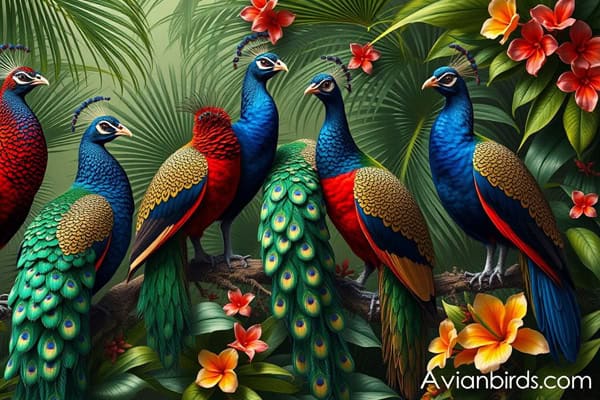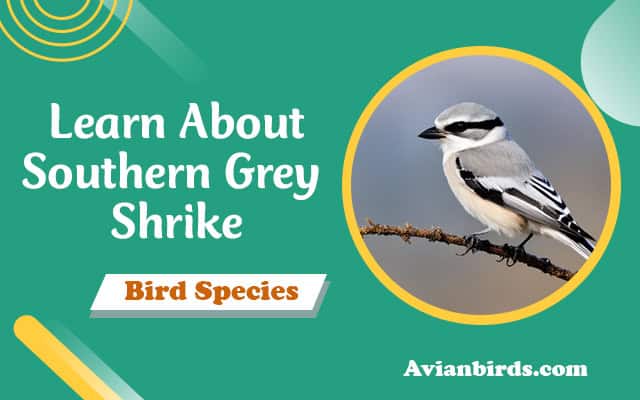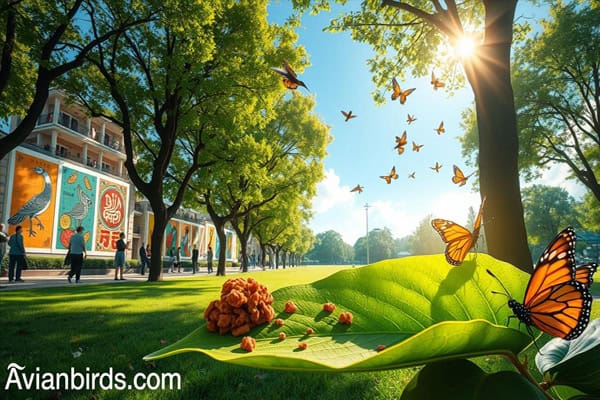6 Types of Birds Similar to Peacocks (ID Guide)
Do you know some birds are Similar to Peacocks? Did you know over 500 bird species are as beautiful and behave like the majestic peacock? This fact shows how diverse and fascinating the world of birds is. Many birds, besides the Indian Peafowl, are just as captivating.
We will look at different peafowl types and their bird look-alikes. We’ll explore their beauty and what makes them special. We’ll also see their roles in nature. Come with us to learn about these colorful birds that are as amazing as peacocks.
What Makes Peacocks So Special?
Peacocks are truly unique in the animal kingdom. They catch our eye with their bright colors and graceful moves. Many cultures see them as royal birds and symbols of beauty and pride.
This special status shows how much we admire these birds. It also shows their important role in our world.
Physical Characteristics of Peafowl
Peafowl have amazing physical traits. Male peacocks are famous for their shiny feathers that change colors. Their long tail, or train, has eye-catching patterns that grab attention, especially when they show off to potential mates.
The Indian Peafowl is known for its bright blue body and big tail. It’s often seen in zoos and gardens. Peafowl come in different colors, like white and black-shouldered types, showing their genetic variety.
This variety in colors is not just beautiful. It also shows the beauty of nature.
1. Peacock Pheasants
- Scientific Name: Polyplectron (various species)
- Size: 50–75 cm (19.7–29.5 in)
- Weight: 1–2 kg (2.2–4.4 lb)
- Lifespan: 10–15 years
- Diet: Seeds, fruits, insects, and small invertebrates.
Peacock pheasants are truly captivating birds, known for their stunning feather displays. They are part of the pheasant family and are often compared to true peacocks. These birds are vital to the world of birds, bringing beauty and uniqueness to the natural world.
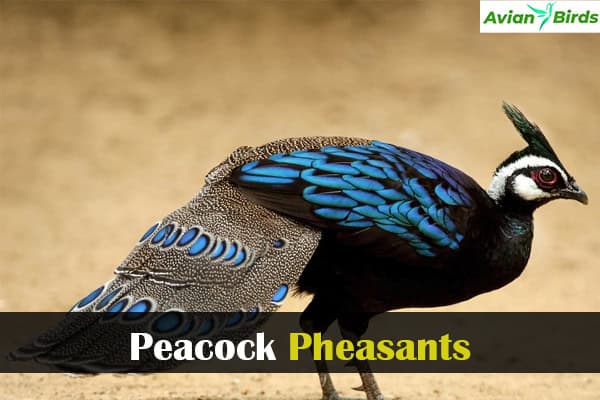
Different Species of Peacock Pheasants
The Palawan Peacock-Pheasant stands out in its bright colors and patterns. It calls the lush forests of the Philippines home. Another species, the Grey Peacock-Pheasant, is known for its beautiful plumes. Each peacock pheasant species has its own unique traits that make it special.
Conservation Status and Habitat
Unfortunately, many peacock pheasants are facing big challenges. Habitat loss and poaching are major threats. The Palawan Peacock-Pheasant is listed as Vulnerable by the IUCN, showing how urgent conservation efforts are needed.
These birds depend on specific habitats, making their survival harder due to environmental changes. It’s crucial to protect their homes to save these endangered species.
2. Pheasants
- Scientific Name: Phasianus colchicus (Common Pheasant)
- Size: 60–90 cm (23.6–35.4 in)
- Weight: 1–1.5 kg (2.2–3.3 lb)
- Lifespan: 3–5 years (up to 10 years in the wild)
- Diet: Seeds, grains, insects, and berries.
Pheasants are fascinating birds with traits that remind us of peacocks. They are known for their impressive breeding displays. Males show off their long feathers in bright patterns and colors. Even though they’re not as colorful as peacocks, pheasants are still beautiful and interesting to watch.

Distinct Traits of Pheasants
Pheasants have some key traits that stand out:
- Elaborate feather patterns with varying colors
- Diverse sizes, with some species being quite large
- Social behavior, often seen in flocks
- Specific vocalizations that distinguish them from other birds
Their colorful feathers and mating displays are especially noteworthy. These displays help them find mates.
Common Pheasant Species
Some common pheasant species include:
- Ring-Necked Pheasant: This species came from China and now thrives in the United States.
- Golden Pheasant: Known for its bright colors, the golden pheasant comes from China’s mountains.
- Lady Amherst’s Pheasant: This species is known for its unique colors and tail feathers.
These are just a few of the stunning pheasant varieties around the world. They show the beauty and diversity of this bird family.
3. Guineafowl
- Scientific Name: Numida meleagris (Helmeted Guineafowl)
- Size: 50–70 cm (19.7–27.6 in)
- Weight: 1.2–1.5 kg (2.6–3.3 lb)
- Lifespan: 10–15 years
- Diet: Seeds, insects, and small invertebrates.
Guineafowl are truly captivating birds. They are known for their unique looks and behaviors. Let’s dive into their social behavior and the bright colors that make them stand out.
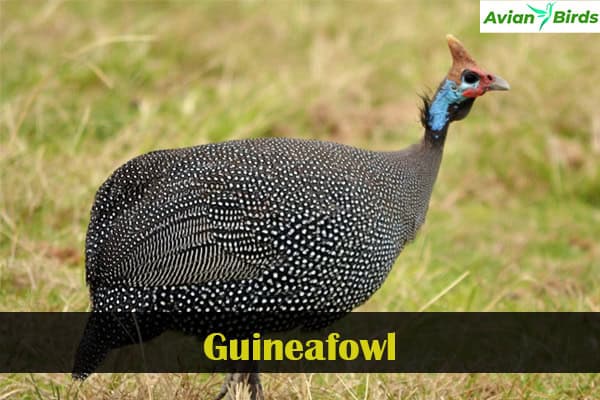
Social Behavior and Personality Traits
Guineafowl are very social birds. They live in close groups that work together well. Also, They have strong feelings about their territory and make a lot of noise to stay connected.
They often live with more than one mate, similar to some peafowl. Guineafowl are brave and will stand up to predators. This bravery makes them very likable.
Color Variants in Guineafowl
Most Guineafowl have gray feathers, but they have striking markings. The helmeted guineafowl has bright blue on its face. In the wild, they stick to their gray look, but in captivity, they show many colors.
These colors make Guineafowl visually stunning. They offer a unique look compared to peafowl.
4. Quetzals
- Scientific Name: Pharomachrus mocinno (Resplendent Quetzal)
- Size: 32–36 cm (12.6–14.2 in)
- Weight: 200–250 g (7.1–8.8 oz)
- Lifespan: 3–5 years (up to 20 years in the wild)
- Diet: Fruits, insects, and small vertebrates.
Quetzals are vibrant birds that live in the lush forests of Central and South America. They are known for their long, elegant tail feathers, especially in males. Their bright colors are just one part of their beauty. Quetzals have unique ways of breeding and nesting that bird lovers find fascinating.
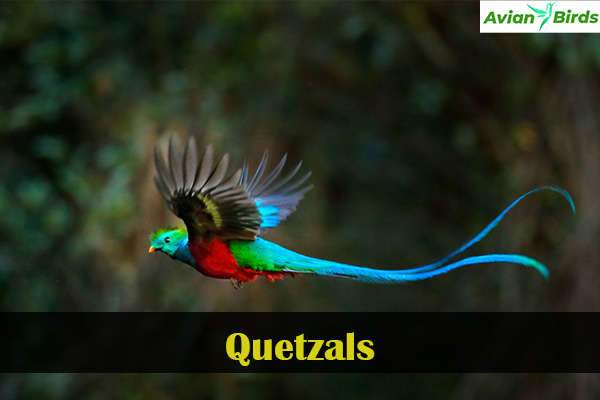
They choose to nest in decaying trees, which keeps their young safe. This shows how much they care for their babies.
Breeding and Nesting Habits
Both male and female quetzals work together during the breeding season. They are very dedicated to each other and their chicks. They pick nest sites in the hollows of old trees for protection and to help their babies survive.
Watching quetzals during breeding season shows how caring they are for their young.
Symbolism of Quetzals in Culture
Quetzals are important in many cultures, especially for their link to liberty. They are hard to catch, which symbolizes freedom and the wild spirit of nature. Their cultural importance shows in stories and art, celebrating independence and beauty.
We learn a lot from the quetzals, connecting us to nature and creativity.
Birds of Paradise: Nature’s Masters of Display
The world of birds of paradise is full of fascinating courtship rituals. These birds put on some of the most detailed mating shows in the animal world. With their bright feathers and dramatic moves, they grab the attention of both potential mates and onlookers.
Distinctive Courtship Rituals
Birds of paradise have special group displays called leks. Here, males compete for the attention of females. Each display shows off their amazing feathers and unique moves, unlike any other mating ritual. They use synchronized movements and loud calls to show off their fitness and get noticed.
These displays help them find mates and show the amazing variety among these birds. It’s a sight to see.
Rare Species Among Birds of Paradise
Some birds of paradise are especially rare, like the Greater Bird of Paradise and Wilson’s Bird of Paradise. Each one has its own special traits and behaviors. They live in specific places, often under certain environmental conditions.
But, changes in their homes because of humans threaten their survival. We want to make people aware of these amazing birds to help protect them.
| Species | Distinct Features | Habitat | Conservation Status |
|---|---|---|---|
| Greater Bird of Paradise | Vibrant yellow and green plumage | Lowland rainforests | Near Threatened |
| Wilson’s Bird of Paradise | Bright red and blue colors | Forest edges and clearings | Vulnerable |
| Satin Bird of Paradise | Metallic green and blue feathers | Cloud forests | Least Concern |
| Blue Bird of Paradise | Striking blue coloration and tail feathers | Lowland tropical forests | Vulnerable |
More Birds Similar to Peacocks
As we explore the world of colorful birds, we see how diverse they are. There are many birds that stand out with their bright colors and interesting behaviors. These birds show us the beauty of nature in many ways.
Exploring Other Colorful Birds
We find amazing birds like trogons with their bright colors and beautiful patterns. They move through the rainforest with colors as bright as peacocks. Exotic passerines also add to the beauty with their colorful feathers and patterns.
Birds with Unique Displays
Many birds have special ways of showing off. The Resplendent Quetzal is one, with its green and red feathers and long tail. Toucans have big beaks and bright colors, and they play in fun ways. These birds are as fascinating as peacocks.
| Bird Species | Coloration | Notable Behavior | Habitat |
|---|---|---|---|
| Trogons | Brilliant colors with striking patterns | Gliding displays through foliage | Rainforests, tropical regions |
| Resplendent Quetzal | Green and red with a long tail | Elaborate courtship flights | Cloud forests of Central America |
| Toucans | Brightly colored bodies with large bills | Playful interactions and vocalizations | Tropical and subtropical forests |
Why Choose Birds Similar to Peacocks?
Birds like peacocks are great for those who love birds. They come in beautiful colors and have traits that make them stand out. It’s important to know how to care for them and how they get along with others.
Captive Care and Compatibility
Looking after colorful birds means understanding their needs and behaviors. Many birds related to peacocks are easy to care for, making them perfect for beginners or experts. Each bird has its own personality, which affects how well it gets along with others.
This means we can mix different birds together to create a lively and colorful home for them.
Aesthetic Appeal and Personality
Birds like peacocks are not just beautiful; they also have unique personalities. Pheasants and guineafowls, for example, have stunning looks and fun movements. They add life to any space.
Choosing pet birds means picking ones that fit our lifestyle and bring us joy. We get to enjoy their beauty and their company.
| Aspect | Bird Species | Care Requirements | Compatibility | Aesthetic Appeal |
|---|---|---|---|---|
| Captive Care | Pheasants | Moderate | High | Colorful plumage and display behaviors |
| Captive Care | Guineafowl | Low | Moderate | Distinctive patterns and social interactions |
| Captive Care | Quetzals | High | Low | Brilliant coloration and elegance |
Conservation and Protection of Related Species
Many bird species like the peacock face big threats that put their survival at risk. We need to understand the challenges they face, like losing their homes, being hunted, and climate change. These birds are losing their natural spaces fast, which means they’re in big trouble and need our help now.
Threats Faced by These Birds
Habitat loss is a big problem for many bird species. As cities grow and farming increases, their homes are disappearing fast. Poaching for feathers, illegal trade, and climate change make things even worse, bringing some birds very close to disappearing forever.
Conservation Efforts and Initiatives
It’s important to save these beautiful birds. Conservation groups work hard to protect them with different plans. Things like saving their homes, teaching people, and breeding programs help keep these birds safe. We can help by joining local conservation events and spreading the word in our communities.
Read More🐦Related Articles:
| Small Birds with Long Legs |
| Red Birds in Florida |
| Small Birds With Long Necks |
| Small Green Birds in Florida |
| Baby Mourning Doves |
Conclusion
Our journey into birds similar to peacocks has shown us the vast beauty of nature. We’ve seen the stunning plumage of peacock pheasants and the unique traits of guineafowl and birds of paradise. Each species proves nature’s skill in creating beauty.
These birds not only amaze us but also play key roles in their environments. They are vital to our planet’s biodiversity. By learning about them, we connect more deeply with all living things.
This knowledge helps us help these birds and their homes. It’s crucial for their survival. By protecting them, we make sure future generations can also enjoy their beauty and behaviors.
Let’s keep valuing and respecting birds and their diversity. Our efforts to save these species are important. Together, we can help keep the beauty of these birds alive. This shows the value of wildlife on our planet.

